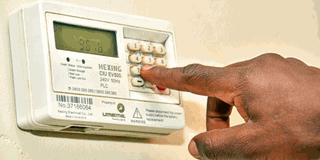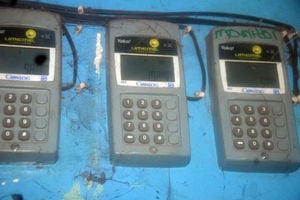
A man loads Yaka tokens. The first electricity purchase in a month comes with 15 lifeline units charged at a discounted cost of Shs250 each. PHOTO/MICHAEL KAKUMIRIZI
BY RONAH NAHABWE
For many pay-as-you-go electricity consumers, buying Yaka units has become a regular activity, but one that’s often clouded by misconceptions.
Social media is awash with complaints as users report some discrepancies in the number of units they receive.
One frustrated customer said, “I bought for Shs10,000 and they gave me 3.8 units,” while another shared, “It is better to buy at the end of the month. I got 18 units for the same amount.”
These comments reflect a broader misunderstanding of how Uganda’s Yaka system operates, especially regarding when to make payments. So what’s the truth?
When should you buy Yaka units?
There is no ideal time to purchase Yaka units. Whether you pay at the beginning or end of the month, the most critical factor is ensuring that your first payment of the month qualifies you for the 15 discounted lifeline units. Any additional payments made afterward won’t receive the same benefit.
Julius Wandera, the director of corporate and consumer affairs at the Electricity Regulatory Authority (ERA), clarifies that it does not matter whether you buy on the first or last day of the month; your entitlement to units does not change.
However, he adds, there is a clear structure to how your payment is processed. The Value Added Tax (VAT), which is 18 percent, is the first deduction from your total payment.
Following this, a monthly service fee of Shs3,360 is subtracted to cover maintenance costs, and the remaining balance is used to purchase tokens or electricity units.
Every consumer is entitled to 15 lifeline units per month, which are charged at a discounted rate of Shs250 per unit. These lifeline units apply only to your first purchase in a calendar month.
After these 15 units are consumed, the next batch (from the 16th to the 79th unit) is charged at the standard domestic rate of Shs803 per unit. If you exceed 79 units in a month, a higher tariff, known as the cooking tariff, applies to units from the 80th to the 150th.
Practical example
Let us break this down with an example.
Assume you are making your first Yaka purchase of the month with Shs30, 000. First, VAT of 18 percent (Shs5, 576) is deducted, which leaves you with Shs25, 424. After that, the monthly standing fee of Shs3,360 is subtracted, bringing your remaining balance to Shs22,064.
With that balance, you can now proceed to buy your Yaka units. The first 15 units, charged Shs250 each, will cost you Shs3,750, leaving Shs18,314. With the current domestic tariff of Shs803 per unit, the remaining balance will buy you 23 units.
In total, you will receive 38 units: 15 lifeline units at the lower rate (Shs250) and 23 units at the standard domestic tariff of Shs803.
The lifeline customer classification
According to Mr Wandera, to qualify as a lifeline customer, your average monthly consumption over the past six months must be less than 100 units. Approximately 92 percent of Yaka customers fall into this category. If your average monthly consumption exceeds 100 units, you don’t qualify for the lifeline units and will be charged the standard rate from the start.
If you make additional payments within the same month, you will still pay VAT (18 percent), but will not be charged the service fee of Shs3,360 again. However, you also won’t receive the lifeline units, as you would have already used them for that month.
This debunks the common myth that waiting until the first day of the month guarantees more units.
In reality, it is your first purchase in the calendar month that matters, not when you buy during the month.
Causes of unit variations
There are several reasons why consumers might notice variations in the number of units they receive. If you skip buying units for several months, the monthly service fee accumulates and is deducted in full the next time you top up. This significantly reduces the amount of money available to buy units.
Additionally, after your first purchase in a month, all future transactions are charged at the standard domestic rate without the discounted lifeline units.
ERA reviews electricity tariffs quarterly, so slight changes in prices may occur if you buy units in different months.
To ensure that consumers are not overcharged and that subsidized units are applied fairly, ERA monitors the entire electricity system in Uganda. According to Mr Wandera, this ensures that all Ugandan electricity consumers are treated fairly, with clear communication on any tariff changes.
Innovations
To address some of the concerns raised by Yaka users, Umeme has been making strides to improve the system. One of their latest efforts involves the rollout of a new Utility Customer Information System (UCIS), which is expected to accommodate up to four million customers.
Peter Kaujju, Umeme’s head of communications, explains that the new system is designed to offer a smoother experience for consumers.
“We have automated all our transactions, phasing out manual cash offices,” says Kaujju, adding: “This is part of a broader effort to provide a faster, safer, and more convenient experience for our customers.”
With the new system, Umeme hopes to centralise all its processes, which will allow customers to seamlessly transact from anywhere.
According to Kaujju, the Yaka system allows consumers to plan their electricity usage.
“You control what you consume, and you can load your account whenever it is convenient,” Kaujju says.
The timing of your Yaka purchases does not affect your entitlement to lifeline units—what matters is that your first transaction of the month will receive the 15 subsidised units.
Additionally, factors such as accumulated service fees, tariff adjustments, and subsequent purchases can affect how many units you receive.
Umeme’s efforts to improve the system through automation and innovation are a step towards offering customers a more reliable and transparent service.



